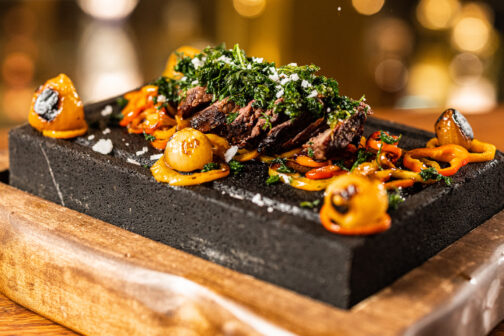Lao New Year, also known as “pi mai,” is April 13 through 15, but the small southeast Asian country celebrates the holiday all month long. That tradition is carried over in Dallas-Fort Worth, where Lao communities come together to ring in the new year at Lao Buddhist temples across North Texas.
Lao New Year happens right before the monsoon season in Laos. Most people pray, shower statues in scented water, hold pageants, and tie white strings that symbolize blessings around each other’s wrists. Then, there’s the food.
Lao New Year festivals are a unique opportunity to try dishes from dozens of vendors in one place. That’s why I reached out to Donny Sirisavath to ask what he looks for at the annual festivals. Sirisavath put Lao food on the map in 2019 when Bon Appétit named his restaurant Khao Noodle Shop No. 2 in the country.
He knows a thing or two about Lao food, and because I’m Lao, so do I. Together, we’ve created your unofficial Lao New Year food guide. Sabaidee pi mai!
Sticky Rice (khao niew)
Sticky rice is glutinous rice that’s been steamed until the individual grains stick together. The rice is meant to be eaten with your hands and accompanies a variety of—if not all—Lao dishes, including dried beef, meat salad, and papaya salad. Most vendors will wrap sticky rice in plastic and keep it warm in insulated coolers until ready to be eaten, but it’s also acceptable to eat at room temperature. (Sometimes it can be really hot, too, so be careful.)
Papaya Salad (thum mak hoong)
A staple at almost every Lao gathering is papaya salad, a vegetable dish made with shredded green papaya, tomatoes, limes, chiles, sugar, fish sauce, and a fermented fish sauce called padaek. The ingredients are pounded together (“thum” in Lao means “to smash” or “to hit”) in a giant mortar and pestle until the papaya is soft and the tomatoes are nicely crushed. Sometimes you can find a cucumber version of this dish, which is equally as cooling and spicy. Pair it with sticky rice or poured over some cold vermicelli noodles.
Baked eggs (khai being)
Sirisavath says baked eggs are a “must” for him at Lao New Year because it’s not a dish often served at restaurants. They’re made by draining yolk and egg whites through a hole at the top of the eggshell and seasoning the yolks with salt, pepper, oyster sauce, sugar, and soy sauce. Once blended, the yolks are whisked together and poured back into the empty eggshells. The eggs are baked upright until the mixture inside is firm.
Meat skewers
Grilled meats are common in Lao meals. Skewered grilled meats are known as street food, and at Lao New Year festivals, finding them is easy: look for billowing smoke among the vendor tents. The meat options include chicken and beef, but vendors also serve innards like chicken hearts, livers, gizzards, and more. Sirisavath says when you order skewers, kindly ask the vendor to reheat them over the grill or make them fresh before they bag them up. Ones that have been sitting out tend to be a bit dry.
Dried beef (seen hang)
At breakfast, lunch, dinner, or even at snack time, dried beef is likely to make an appearance. Dried beef can look different based on how you like it. For a meatier bite, a chunk of sirloin is cut into strips before being tossed in salt, pepper, and garlic and dried for at least a day. The strips are then grilled and often look blackened or dark in color.
For crispy dried beef, the meat is thinly sliced and dried. The slices are then flash-fried and sprinkled with sesame seeds for serving. Thin dried beef looks dark red and is chip-like. You’ll usually find the latter at Lao New Year served in clear plastic boxes or wrapped in plastic on a Styrofoam tray.
Lao chicken noodle soup (khao piak sen)
“Khao piak sen” translates to “wet rice noodle.” In Laos, this dish is a soup dish with chicken broth and homemade flour noodles. It’s great for a cold day, but it’s not uncommon to find this dish as a comfort meal on a hot day, either. Vendors who sell khao piak sen will normally have tables and chairs available for you to sit down and enjoy a bowl. Garnish with fried garlic, green onions, cilantro, and a spoonful of chile oil.
Meat salad (laab)
The national dish of Laos is meat salad, also known as laab, an herby meat dish seasoned with toasted sticky rice powder, fermented fish sauce, onions, lemongrass, garlic, and more. The meat varies from chicken, beef, fish, duck, or pork, which can be served in a variety of ways. Laab can be served hot or cold—at Lao New Year, you’ll likely find it at room temperature or cold. Eat it with your hands and a mound of warm sticky rice and freshly sliced cucumbers.
Fried plantains (juen kuay)
Sirisavath and I both say this with our whole hearts: fried plantains are the best. At Lao New Year, vendors deep fry battered plantains by the dozen. A bag of these will typically go for $5, and each fried piece contains soft and sweet plantains surrounded by a thick, crunchy, sesame-flavored crust. They’re best when they’re fresh out of the fryer. Most vendors selling fried plantains will also sell fried taro, yams, and sweet potatoes.
Sirisavath avoids those and goes straight for the plantains. “The best is the fried banana,” he says.
Sweet coconut milk with tapioca, fruit, and pandan noodles (nam wan)
Nam wan means “sweet water,” but this sweetened coconut milk-based dessert also has tapioca, green pandan noodles, and sometimes cantaloupe. It’s best eaten cold, but you can also buy a bag of squiggly pandan noodles at the festival and put the dessert together at home.
Sticky rice in bamboo (khao lam)
For another dessert that isn’t overly sweet, try the sticky rice in bamboo, which can be found near the same vendors making skewers. Bamboo sticks are stuffed with deep purple coconut rice and left to heat up on top of a grill. To open, peel back the bamboo long ways and unveil steaming hot rice. Sometimes chunks of taro are added for texture. You can eat this on its own, but to level up, find a stand with ripe sliced mangos and try it together.
Coconut sticky rice in banana leaf (khao nom nap)
Another common dessert (and one you can often find at temples when worshippers give alms to monks) is sweet rice filled with coconut shavings and brown sugar and steamed in banana leaf. They can come packaged in a variety of shapes, the most common being a triangular pyramid. A similar dessert, a sticky rice with bananas (khao tom), is also available for sale if you can find it. “Those are kind of rare,” he says. “But if you can find those, they’re pretty good.”
Lao New Year festival dates
Wat Lao Santithammaram (Wat Kimbo)
March 31-April 2 | 3000 Kimbo Rd., Fort Worth.
Wat Lao Buddhasamarkee Buddhist Temple of Fort Worth
April 8-9 | 8805 Wagley Robertson Rd., Fort Worth.
Cambodian Buddhist Temple of Dallas (Khmer New Year)
April 15-16 | 5701 Crystal Lake Blvd.
Wat Lao Siribuddhavas (Wat Rockwall)
April 21-23 | 2772 Blackland Rd., Royse City
Wat Lao Thepnimith of Fort Worth (Wat Saginaw)
April 28-30 | 7105 Marvin Brown St, Fort Worth
Author







